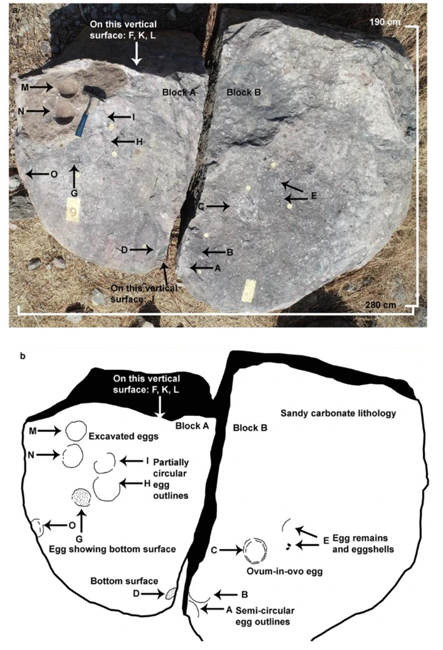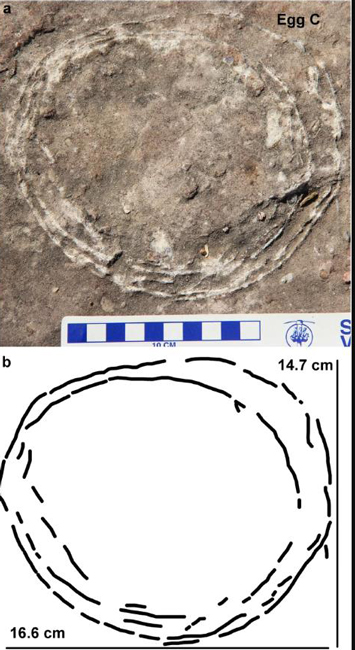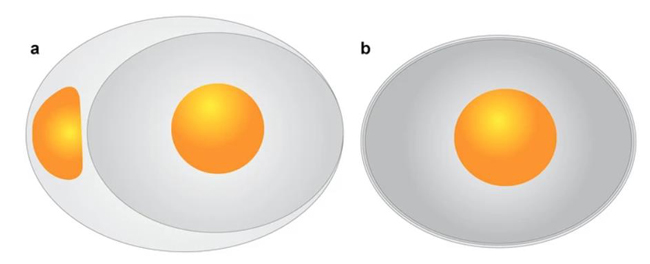The discovery of a titanosaurid egg, preserved inside another titanosaur egg (ovum-in-ovo) adds weight to the theory that dinosaurs had a reproduction strategy very similar to birds. This discovery opens up the possibility that dinosaurs laid their eggs sequentially like birds, whereas other reptiles tend to lay eggs simultaneously as a clutch.
The researchers from the University of Delhi in collaboration with a colleague from the Higher Secondary School (Dhar District, Madhya Pradesh), documented the contents of a titanosaur nest discovered in Upper Cretaceous deposits (Maastrichtian stage) from the Lameta Formation exposed in the lower Narmada valley. The Lameta Formation is famous for its titanosaur nest fossils, hundreds of individual nests have been recorded. The titanosaur nest which records a rare example of an abnormal egg is known as P7, it is one of fifty-two titanosaur nests that have been mapped around the village of Padlya.

In-situ field photograph and explanatory drawing of the outcrop showing the titanosaur nest P7 and its eggs and eggshell fragments. Captions A to O indicate eggs and eggshell locations. Picture credit: Dhiman et al.
Picture credit: Dhiman et al
Titanosaur Nest P7
The titanosaur nest P7 preserves eleven large, round eggs which are placed in a circular arrangement entombed within a block of sandy limestone. Not all the eggs are entire, some of the eggshell is missing. They could represent broken shells after the eggs hatched or the missing shell elements may have been eroded away.
One egg (egg C) records unusual pathology. Two partially broken, circular eggshell outlines are preserved, with a prominent crescent-shaped gap between the two eggshells present in the top right corner (see line drawing). Egg C has been interpreted as an example of an abnormal egg, one egg containing another egg within it. This type of egg pathology is termed ovum-in-ovo and this is the first time this has been reported in a dinosaur. Ovum-in-ovo eggs are found in birds but no such egg pathology has been reported in a reptile (living or extinct). This discovery suggests that titanosaurids had a reproductive system similar to that of birds.

In-situ field photograph (a) of the ovum-in-ovo egg (egg number C) from the Upper Cretaceous Lameta Formation (Dhar District, India) with explanatory line drawing (b). Two partially broken, circular eggshell outlines can be seen with broken eggshell fragments also preserved. With ovum-in-ovo egg pathology a crescent-shaped gap is characteristically present in the upper right part of the egg. Picture credit: Dhiman et al
Picture credit: Dhiman et al
Different Types of Egg Pathology
Abnormal egg formation has been documented in many types of amniote (undergoing foetal or embryonic development within a protective membrane, the amnion), such as turtles, dinosaurs and birds. Two main examples of egg pathology are known. There is a condition where one egg forms within another egg (ovum-in-ovo) and a second condition in which multi-shelled eggs are formed, essentially the formation of a second eggshell layer beside the primary eggshell.

Unusual pathologies in amniote eggs. Ovum-in-ovo (a) an egg within an egg, characterised by the presence of two yolks. Multi-shelled egg (b) with two or more eggshell layers surrounding a single yolk. Picture credit: Dhiman et al (after Carpenter).
Picture credit: Dhiman et al (after Carpenter)
If Egg C represents an example of ovum-in-ovo egg laying in a dinosaur, then this egg deformity will only have been recorded in the Dinosauria and birds, suggesting similar reproductive biology. In birds, when an egg is fully formed it is pushed into the cloaca to be laid one-by-one.
Eggs are not laid as clutch, but egg laying can take place sequentially over several days. In birds such as hens (Galliformes), egg laying can be suspended if conditions are unfavourable. However, crocodiles and turtles tend to lay all their eggs at the same time, as a single clutch. Both turtles and crocodiles have two oviducts, but crocodiles are more derived than turtles possessing a segmented oviduct and share this derived trait with the birds.
The structure of the oviduct dictates the sort of egg abnormalities that can occur. The ovum-in-ovo pathology as observed in the titanosaur eggs has led the researchers to hypothesise that titanosaurs possessed a segmented oviduct similar to birds and crocodiles, but unlike crocodilians they were capable of laying eggs sequentially.

Inferred cladogram showing divergence of dinosaurs from crocodiles on the basis of sequential egg laying. Picture credit: Dhiman et al.
Picture credit: Dhiman et al.
Building up a Picture of Titanosaurid Reproductive Strategy
Turtles, crocodiles, dinosaurs and birds all share the common trait of having multi-shelled eggs. Both turtles and crocodiles have two oviducts, but crocodiles are more derived than turtles in that they possess a segmented oviduct, a characteristic that they share with birds.
This new study suggests that at least one type of dinosaur (titanosaurids) had an oviduct anatomy and biology similar to modern birds. Titanosaurs may have been capable of laying eggs sequentially, just like birds.
Palaeontologists are building up a detailed picture of titanosaur reproductive behaviour. These sauropods had favoured nesting sites, which they returned to, they nested in colonies, excavated nests and covered the nests to incubate the eggs and they may have laid their eggs not as a single clutch but sequentially over several days.

The titanosaur egg fossils were found in two distinct layers (L1 and L2) approximately two metres apart. This suggests that this area was a preferred nesting site for titanosaurs. This is the first confirmed dinosaur nesting area found in Brazil. The eggs attributed to titanosaurs also represent the most northerly titanosaurian nesting site known from South America. The discovery of nests located at different levels indicates that titanosaurs returned regularly to preferred nesting areas. Picture credit: Fiorelli et al.
Picture credit: Fiorelli et al
Safari Ltd recently introduced a model of a titanosaur (Patagotitan). To view this figure and the other models in the Wild Safari Prehistoric World range: Wild Safari Prehistoric World.
The scientific report: “First ovum-in-ovo pathological titanosaurid egg throws light on the reproductive biology of sauropod dinosaurs” by Harsha Dhiman, Vishal Verma & Guntupalli V. R. Prasad published in Scientific Reports.
The award-winning Everything Dinosaur website: Dinosaur Figures.






Leave A Comment